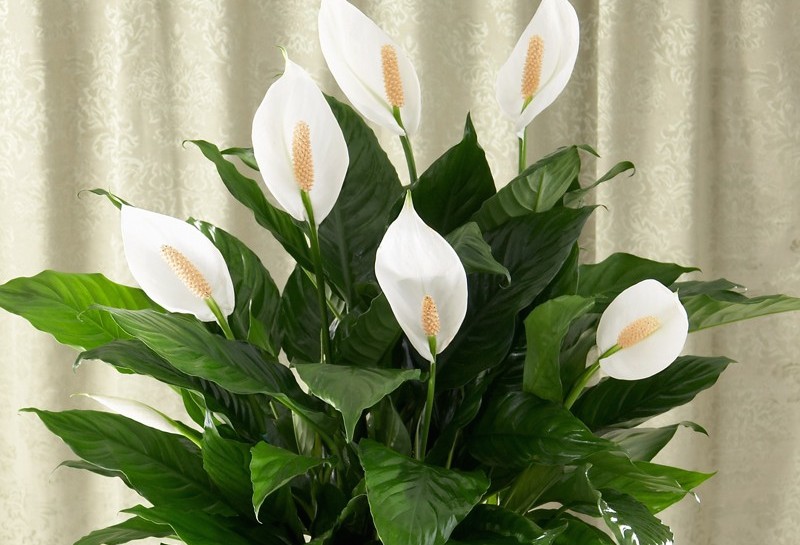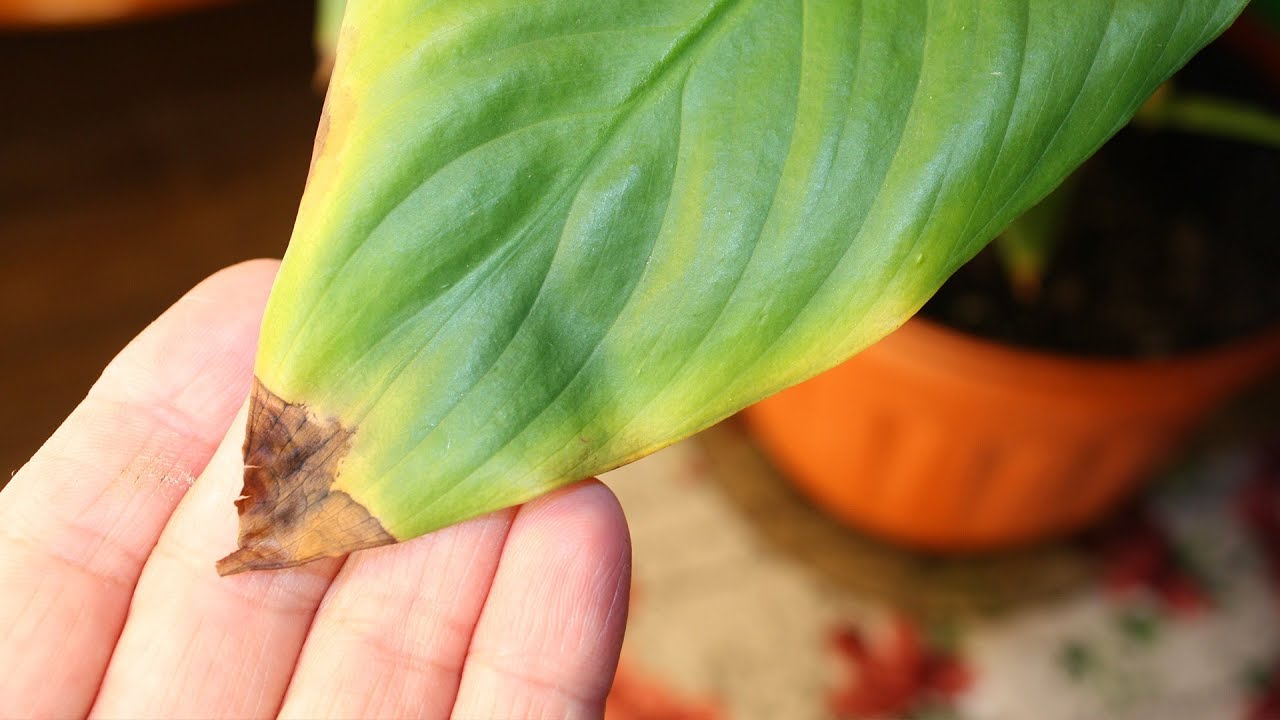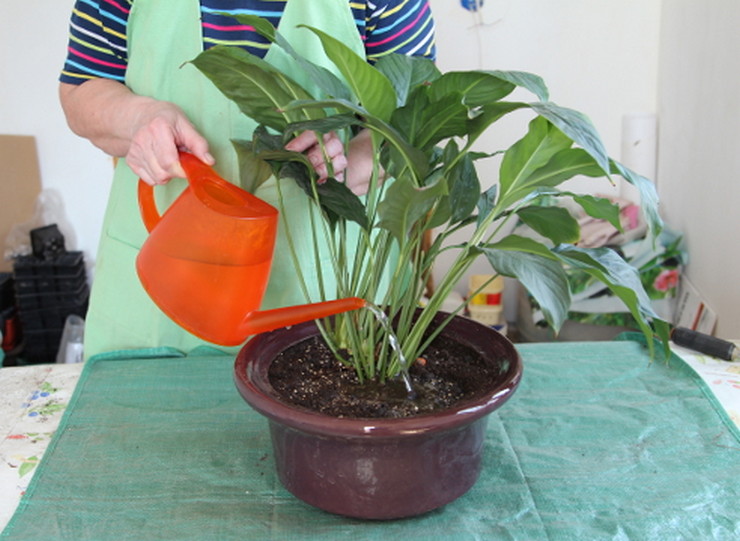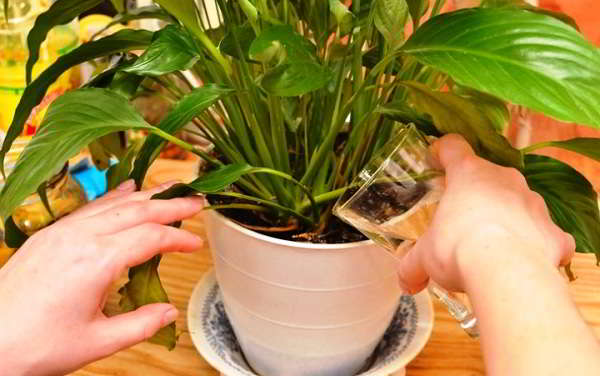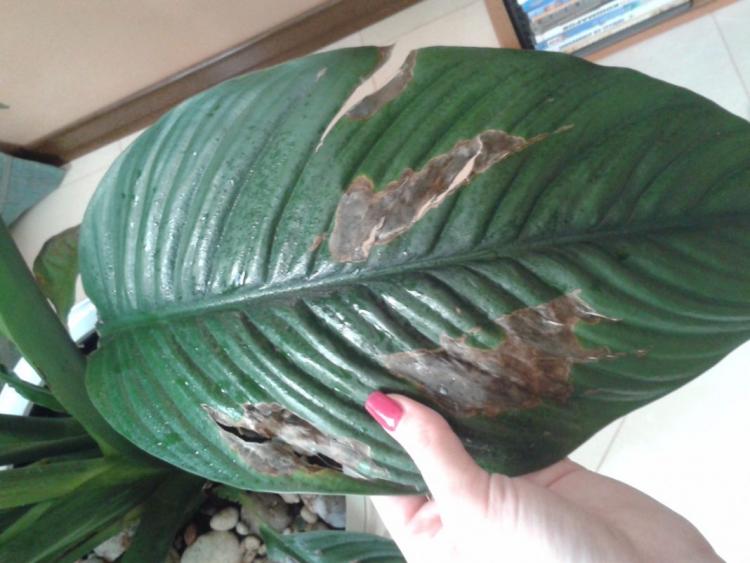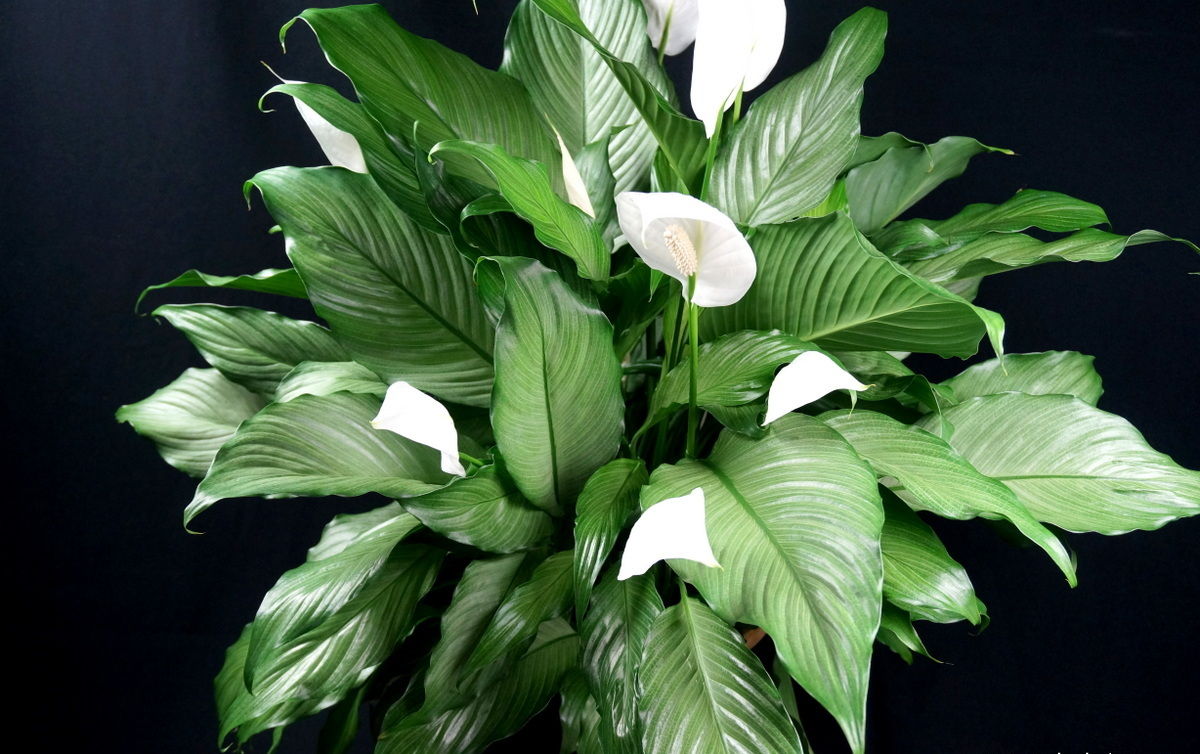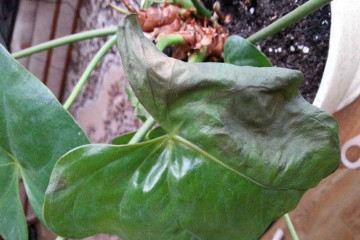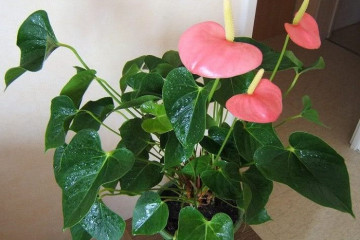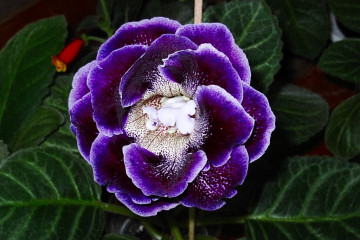Spathiphyllum - leaves turn black at the edges, what to do
Content:
Spathiphyllum is a beautiful houseplant that is often called "female happiness". This culture has excellent decorative properties of leaves and flowers. It is easy to clean. At the same time, sometimes when growing a plant, various problems appear. If spathiphyllum is grown, the leaves turn black at the edges, what to do in such a situation? This question worries many inexperienced florists.
Signs of dry and wet blackening of spathiphyllum leaves
Darkening of foliage is the process of the appearance of black or brown spots on its surface. Subsequently, they deform and dry out. Initially, the leaf plate may turn yellow. Then it acquires a dark shade, blackens, dies off.
The leaf can be covered with dark spots evenly or randomly. If you do not take action in time and start treating the bush, the leaves completely turn black and die off. Moreover, at the very beginning of this process, all the decorativeness of "female happiness" is lost.
If the leaves of spathiphyllum turn black, this indicates a violation of the rules for caring for the crop. Outwardly, this symptom may look different:
- The ends of the leaves of the spathiphyllum dry up and darken. This creates a large brown area around the edges. After some time, these fragments dry out and become more fragile. Affected leaves die off and crumble. If they do not fall off, the bush still becomes less decorative. In this case, we are talking about dry blackness.
- There is also a sluggish or weeping darkening. At the same time, black leaves acquire a moist consistency and become softer and slippery. They are losing their density. This phenomenon often becomes very widespread and widespread. Spores, mold, fungi are often formed on the affected area.
It should be borne in mind that the ends of the leaves or the entire plate may darken in the plant. Also, the roots and flowers of the plant sometimes acquire black color. Depending on the provoking factor, the affected fragments grow rapidly.
Why do the leaves of the flower "female happiness" dry and turn black
If dark spots, black tips or roots suddenly appear on a healthy bush, you need to take immediate action. Such symptoms can be associated with any one cause or a whole complex of factors.
If spathiphyllum darkens due to improper care, it can be saved. In difficult cases, rotting or the development of a fungal disease begins. If you do not start treating the plant in time, it will die. In advanced cases, the entire flower may turn black and dry. In such a situation, nothing can be done, you will have to throw it out, thoroughly disinfect the container or not use it at all.
Insufficient air humidity
In order for spathiphyllum to grow and develop normally, it requires optimal moisture parameters and timely watering. With a moisture deficit, dryness of the tips of the leaves is often observed. In order for the plant to grow normally, it needs periodic spraying with water. The procedure should be carried out once a week. In the winter season, it is permissible to do this more often.
The cold season is considered a real challenge for the culture. Heating sources dry the air and cause root burns. Therefore, the pot with spathiphyllum should not be placed on the windowsill, under which the battery is located.
To avoid problems when growing crops, you need to put a special shelf in the window opening. Thanks to this, the plant will not overheat and will be able to receive the required amount of sunlight. It is advisable to place a container with water near the culture. As the liquid evaporates, it will be possible to increase the air humidity in the room.
Stagnant moisture in the pot due to over-watering or heavy soil
This is a complex problem that causes dry foliage. Excess moisture denies a negative effect on the condition of the root system. Therefore, water should not always remain in the bowl under the flower. After watering, it should be drained. Next time you need to water the plant as the top layer of the soil dries.
For full aeration of the root system and long-term preservation of moisture parameters when transplanting a flower, the pot should be filled with expanded clay. The drainage layer should be about 5 cm thick.
Culture requires the use of an appropriate substrate. Too heavy soil leads to stagnation of moisture at the roots of the plant. This provokes the development of decay processes. When choosing a soil for a culture, you should pay attention to its composition. It should include soil, peat, bark and leaf debris.
If it was not possible to purchase ready-made soil, you can do it yourself. To do this, in equal proportions, you should mix sand, earth, peat, soil for orchids. At the bottom of the container, stones or expanded clay should be poured.
Sunburn
Spathiphyllum is considered a shade-loving culture. In saturated sunlight, a burn of the tips of the leaves is observed.
In such a situation, the culture gets sick and gradually dies. This is especially noticeable when the culture is located on the south side. The flower needs to be moved to the north window. This will help solve the problem.
Fungal infections
When infected with fungi, the leaves become covered with black spots. In this case, the damaged fragments acquire a weeping and loose structure. Often, spots and other elements of a brown shade appear on the bushes. This is a very dangerous symptom that indicates root damage.
It is caused by the oversaturation of the earth with water or a strong decrease in the temperature indicators in the room. Infections can quickly spread to nearby plants as fungal spores spread easily through the air.
Drafts and sudden temperature changes
Sudden fluctuations in temperature negatively affect the overall health of the culture. At the same time, the leaves turn yellow and the tips of the leaves of the spathiphyllum turn black. The plant is considered to be very thermophilic.
If drafts or a sharp decrease in temperature parameters are observed, the leaves will immediately wither. With a slight hypothermia, the flower can restore its elasticity, but the dark dry ends remain.
Excess or lack of nutrients
Yellowing or blackening of the leaves may be associated with a deficiency or excess of mineral fertilizers.After some time, soil depletion occurs. At the same time, the culture reacts sharply negatively to the deficiency of useful elements.
The flower needs to be systematically fed. At the same time, the frequency of depositing funds depends on the seasonal factor and the state of the culture.
Blackening localization and treatment
A healthy crop should have bright green leaves with a dense structure. They should not have yellow, brown or black elements. Depending on the localization of the problems, it will be possible to find the right treatment.
How to save spathiphyllum if the leaves turn black entirely
When dark spots appear on the leaves, the influence of various factors can be suspected. First of all, they should include fungal infections. Black rot is primarily thought to be the cause of the problem.
Humid cold air and excessive watering are favorable conditions for the development of such pathologies. If symptoms of the disease appear, action should be taken immediately.
Then remove the bush from the pot and examine its roots.
- Dried, rotten or black fragments should be trimmed with a sharp knife.
- The damaged areas should be sprinkled with crushed activated carbon or cinnamon powder.
- Then treat the culture with a solution of Topsin or Fundazol with a concentration of 0.2%. Immersion of the culture in the chemical composition will help to achieve excellent results.
- Then the flower needs to be transplanted into new soil and the pot changed.
Subsequently, you need to normalize the amount of watering. After a couple of weeks, the bush must be treated again with a fungicidal preparation.
What to do if only the tips of the leaves darken
The darkening of the tips of the leaves in a houseplant can be due to a variety of factors. The main reason is considered to be an excessive amount of mineral fertilizers. Many growers actively feed the bush in the hope of getting juicy foliage and beautiful flowering. Instead, however, the edges of the leaves turn black and become drier.
To cope with the problem, you need to pull the plant out of the container and clean it of excess soil. After that, rinse the roots under a stream of warm water and replace the soil. Add a small amount of vermiculite or perlite to the finished substrate. This will help make it lighter and looser. After that, you can transplant spathiphyllum.
How to treat "female happiness" if both leaves and flowers turn black
Such problems appear in spathiphyllum quite rarely. The plant can hardly tolerate excess moisture. In such a situation, there is a risk of blackening of the center and edges of the flowers.
To cope with this problem, you need to control the irrigation system. It is not recommended to allow stagnation of liquid in the soil. A quarter of an hour after moisturizing, you need to get rid of the excess liquid. In a critical situation, spathiphyllum needs to be transplanted.
Prevention of wet and dry blackening
Coping with blackening of leaf blades is quite easy if you properly care for the crop. In this case, you need to follow a number of recommendations. With excessive soil moisture, it is worth reducing the number of irrigations.
If this does not work and the foliage continues to turn black, this indicates rotting of the root system. In such a situation, the plant needs a transplant. In this case, the bush must be pulled out of the pot and get rid of the remnants of old soil from the roots.Then they should be examined and diseased and rotten fragments removed.
After that, the spathiphyllum can be moved to a new soil. It is important to ensure that the soil is not too heavy. Of no small importance is high-quality drainage to remove excess moisture.
If the leaves acquire a dark shade due to a lack of liquid, it is worth making adjustments to the irrigation regime and systematically spraying the culture. This increases the humidity in the air.
It is helpful to place the plant pot in a tray filled with wet sand or pebbles. This helps maintain optimal moisture conditions around the plant.
When caring for the crop, fertilizer should be periodically applied. It should be borne in mind that it is difficult for her to perceive the lack and excess of fertilizing. Therefore, they should be entered very carefully.
In order for the bush to have beautiful green foliage, it needs stable temperature readings. The plant requires parameters at the level of + 22-25 degrees. The bush can hardly stand the heat. Therefore, it must be systematically sprayed and watered abundantly.
In winter, the temperature should not be less than +17 degrees. In this case, it is advisable to place the spathiphyllum away from heating sources. The bush should be located in areas with minimal air movement.
The plant needs bright and diffused lighting. However, spathiphyllum is considered a shade-tolerant plant. It can be grown in partial shade and even placed on northern windowsills.
Water the bush systematically. Drying out of the soil negatively affects the development of the bush. But it is strictly forbidden to flood the plant. Stagnation of moisture provokes the development of root rot. Usually, the bush should be watered when the top layer of soil dries up by 1 cm.The plant needs high humidity. It needs to be sprayed with warm water every day.
The culture needs to be fed regularly. For this, it is worth using combined mineral fertilizers. Such funds are used from March to the end of September. In early spring, top dressing should be used for decorative deciduous crops. In mid-May, it is worth applying fertilizer to flowering plants. You need to add nutrients every 2 weeks. It is not recommended to feed the bushes in autumn and winter.
Young plants need to be replanted every year. Mature bushes can be moved to a new location at intervals of 2-3 years. A slightly acidic soil should be selected for the culture. Moreover, there should be no lime in it.
Darkening of the leaves of spathiphyllum is considered a rather serious problem. To cope with this violation, you need to establish a provoking factor and find an effective treatment.
